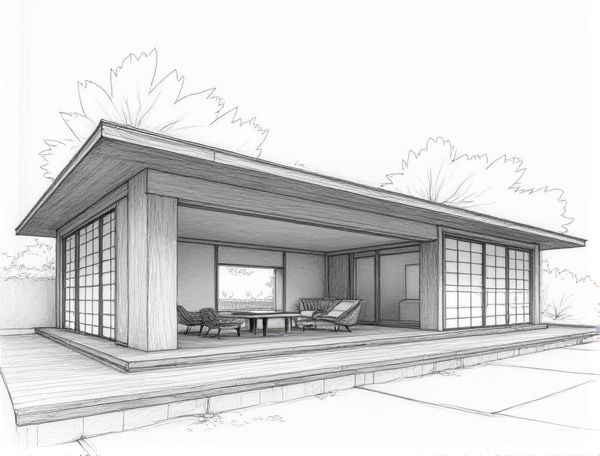
Photo illustration: Minimalist home design with Japanese shoji screens
Minimalist home design embraces simplicity and clean lines, and incorporating Japanese shoji screens enhances this aesthetic by allowing natural light to filter softly while providing privacy. Discover how to transform Your living space with the elegant functionality of shoji screens by reading more in the article.
Introduction to Minimalist Home Design
Minimalist home design emphasizes clean lines, open spaces, and a neutral color palette to create an uncluttered and serene living environment. Key elements include functional furniture, natural light optimization, and the thoughtful use of materials like wood, metal, and glass. This design approach enhances spatial flow and promotes mental clarity by reducing visual distractions.
The Essence of Japanese Shoji Screens
Japanese Shoji screens embody the perfect fusion of elegance and functionality, utilizing translucent washi paper framed by lightweight wooden grids to softly diffuse natural light and create harmonious living spaces. Your home design benefits from Shoji's minimalist aesthetic and space-saving qualities, enhancing tranquility while maintaining privacy and an open atmosphere.
Benefits of Incorporating Shoji Screens in Minimalist Spaces
Shoji screens enhance minimalist spaces by maximizing natural light while maintaining privacy, creating a serene and airy atmosphere in Your home. Their lightweight, translucent design also contributes to spatial flexibility, allowing easy room division without compromising openness.
Choosing the Right Materials for Shoji Screens
Selecting natural materials such as rice paper and lightweight wood like cedar enhances the traditional aesthetic and durability of shoji screens, ensuring both elegance and functionality. Opting for moisture-resistant finishes and sturdy timber improves longevity, especially in humid environments, making the screens a timeless addition to any home design.
Room Dividers: Creating Flexible Spaces
Room dividers enhance home design by defining flexible spaces without permanent walls, allowing customization for privacy or openness. Materials like glass, wood, or fabric create visual separation while maintaining light flow, optimizing both aesthetics and functionality. Incorporating movable or foldable dividers supports adaptable living areas, ideal for transforming rooms to meet varied needs.
Enhancing Natural Light with Shoji Screens
Shoji screens effectively diffuse sunlight, creating a soft, ambient glow that brightens your living space without harsh glare or shadows. Incorporating these traditional Japanese panels enhances interior aesthetics while promoting energy efficiency through natural light optimization.
Harmonizing Minimalist Furniture with Japanese Aesthetics
Harmonizing minimalist furniture with Japanese aesthetics creates a serene and balanced living space by emphasizing simplicity, natural materials, and clean lines. Incorporating tatami mats, shoji screens, and low-profile wooden furniture accentuates the harmony between functionality and traditional design principles. Soft neutral tones and strategic use of negative space enhance the tranquil ambiance, aligning perfectly with the wabi-sabi philosophy of understated beauty.
Color Palettes for a Serene Minimalist Interior
Serene minimalist interiors thrive on muted color palettes featuring soft neutrals like dove gray, warm beige, and crisp white, which enhance calmness and spatial clarity. Incorporating subtle accent shades such as pale blue or sage green introduces gentle visual interest while maintaining the overall tranquility. Selecting matte finishes and natural textures in these hues further elevates the soothing atmosphere essential to minimalist home design.
Practical Tips for Installing Shoji Screens at Home
Measure the space precisely to ensure Shoji screens fit seamlessly and maintain their traditional aesthetic. Use lightweight wooden frames and rice paper panels for easy installation and authentic appearance. Secure the screens with wall-mounted tracks or floor guides to allow smooth sliding and maximize room functionality.
Maintaining Simplicity and Tranquility in Design
Maintaining simplicity and tranquility in home design enhances the sense of calm and spaciousness, using neutral color palettes and minimalistic furniture to reduce visual clutter. Thoughtful placement of natural elements such as indoor plants and ample natural light fosters a serene atmosphere. Incorporating clean lines and open layouts supports a balanced, peaceful living environment that promotes relaxation and well-being.
 homedesy.com
homedesy.com